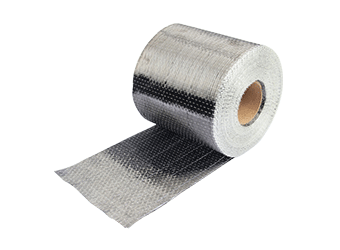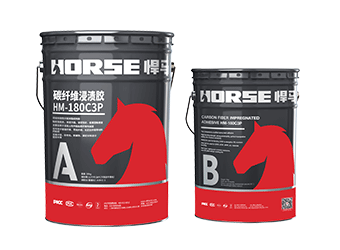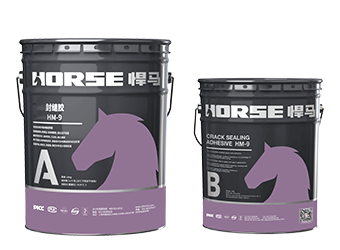Solutions
Horse Construction offers full range of structural strengthening materials with technical supports, documentation supports, products supports, project supports.
Repairing Corrosion-Damaged Concrete Beams (10-15mm Cracks): The Role of Carbon Fiber Materials
Q: Can we repair Sevier damage concrete beams due to corrosion using carbon fiber crack width is nealy 10 t0 15 mm along the beam
A: It is feasible to use carbon fiber materials for the reinforcement and repair of severely corroded concrete beams with crack widths ranging from 10 to 15 mm, but carbon fiber alone cannot fully address the problem.
This is because cracks of 10 - 15 mm are extremely wide for concrete structures (far exceeding the 0.5 mm threshold for dangerous cracks specified in relevant standards), and such severe cracking is caused by steel bar corrosion. The corrosion will not only expand the cracks but also reduce the cross - sectional area of the steel bars and weaken their bearing capacity.
Therefore, a combined repair plan of first treating the crack and corrosion root causes, then using carbon fiber to reinforce the structure is required. The specific implementation steps and key points are as follows:
Pre - repair inspection and root - cause treatment
Comprehensive structural detection: First, use ultrasonic flaw detectors and crack width gauges to confirm the depth of the cracks (whether they are through - cracks) and their extension range. At the same time, check the corrosion degree of the internal steel bars—such as the reduction in the cross - sectional area of the steel bars and the scope of rust spread—through drilling or non - destructive testing. This helps determine the subsequent repair materials and reinforcement scope.
Corrosion treatment of steel bars: For areas where the concrete cover has spalled due to corrosion, chisel away the loose concrete along the cracks until the sound concrete substrate and intact steel bars are exposed. Remove rust from the corroded steel bars with a wire brush, and apply anti - corrosion coating to prevent secondary corrosion. If the cross - sectional area of the steel bars has been significantly reduced, supplement with additional steel bars according to the structural calculation requirements to restore the basic load - bearing capacity of the beam.
Filling and sealing wide cracks: Since 10 - 15 mm wide cracks cannot be directly bonded with carbon fiber, they need to be filled first with a "U - groove filling method". Chisel a U - shaped groove along the crack (the width should be twice the crack width and the depth not less than 20 mm), clean the groove with high - pressure air to remove dust and debris, and then fill it with polymer - modified epoxy mortar in layers. After the mortar cures, polish the surface to make it flat, which lays a solid foundation for the subsequent bonding of carbon fiber.
Carbon fiber reinforcement construction to improve structural bearing capacity
This step mainly relies on the high tensile strength of carbon fiber sheet to enhance the flexural and shear capacity of the concrete beam and prevent the recurrence of cracks.
Base surface treatment: Polish the surface of the repaired beam with an angle grinder to remove laitance and oil stains. For corners and edges, grind them into arcs with a radius of no less than 20 mm to avoid damaging the carbon fiber sheet. Finally, use compressed air to blow away the dust to ensure the base surface is clean and dry.
Glue application and sheet pasting: Apply the bottom coat evenly on the base surface. After the bottom coat is touch - dry, brush the impregnating adhesive. Then lay the pre - cut carbon fiber sheet flat on the adhesive - coated area. Use a defoaming roller to roll along the fiber direction repeatedly to squeeze out air bubbles and ensure the adhesive fully soaks the sheet. If multiple layers of carbon fiber sheet are needed for reinforcement, repeat the gluing and pasting steps, and ensure the lap length between layers is no less than 150 mm.
Curing and protection: After pasting, let the carbon fiber sheet cure at room temperature for at least 72 hours, and avoid disturbing the structure during this period. After curing, brush a layer of protective surface adhesive on the surface of the carbon fiber sheet to resist UV radiation and mechanical wear, thereby extending the service life of the reinforcement layer.
Post - repair quality inspection and follow - up evaluation
Conduct a hammering test on the bonded area of the carbon fiber cloth to ensure the empty drum area does not exceed 5% of the total bonded area. If there are large empty drums, rework the relevant parts in a timely manner.
For key engineering beams, carry out a static load test after repair to verify whether the flexural capacity and stiffness of the beam meet the design requirements.
Conduct regular follow - up observations within 1 - 2 years after repair, using a crack gauge to monitor whether new cracks appear or existing cracks expand, so as to take timely supplementary measures if necessary.
Carbon fiber is a core material for the structural reinforcement of such severely damaged beams. However, the premise is to eliminate the hidden dangers of corrosion and fill the wide cracks first.
You can find anything here you are in need of, have a trust trying on these products, you will find the big difference after that.

High strength, unidirectional carbon fiber wrap pre-saturated to form a carbon fiber reinforced polymer (CFRP) wrap used to strengthen structural concrete elements.

Good impregnation carbon fiber adhesive for applying carbon fiber reinforced polymer(CFRP) wrap for structural strengthening

High strength crack sealing repairing adhesive for the fracture surface of concrete crack